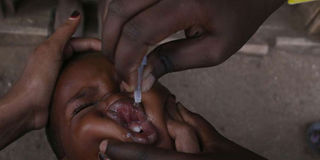Concern as baby immunisation coverage in Africa stalls

Polio vaccination at Kambi Odha in Isiolo County on January 18, 2017. Kenya must look for new, long-term ways of financing child immunisations because donor support is shrinking. PHOTO | PHOEBE OKALL | NATION MEDIA GROUP
What you need to know:
- Immunisation coverage is measured by percentage of children receiving the third dose of the diphtheria-tetanus-pertussis vaccine.
- Vaccine-preventable diseases kill more than 500,000 children under five years of age every year in Africa.
Immunisation coverage in Africa has stagnated at 74 per cent in recent years despite the continent making significant gains towards increasing access in the last few decades, a principal advisory group to the World Health Organization (WHO) has warned.
Immunisation coverage is measured by percentage of children receiving the third dose of the diphtheria-tetanus-pertussis vaccine (DTP3), which helps children (younger than seven years) develop immunity to three deadly diseases caused by bacteria: diphtheria, tetanus, and whooping cough (pertussis).
At the current pace, the Regional Immunisation Technical Advisory Group (RITAG), which serves as the principal advisory group to the WHO, said that the region is off track to achieve the Global Vaccine Action Plan (GVAP) and the Africa Regional Strategic Plan for Immunisation target of 90 per cent national coverage by 2020.
“We have made great strides in recent years, but there is much work to be done to ensure that all children – no matter where they live – have access to the life-saving vaccines they need.
"Even one child still losing its life to a preventable disease is one child too many,” Dr Matshidiso Moeti, WHO’s Regional Director for Africa, said.
VACCINATION DECLINE
According to the GVAP 2017 report, vaccine-preventable diseases kill more than 500,000 children under five years of age every year in Africa – representing approximately 56 per cent of global deaths.
In Kenya, data from the Ministry of Health shows national immunisation coverage has dropped from 85 per cent to 68 per cent.
The data also indicates that the number of children without compulsory vaccination of any sort rose from 157,584 to 265,523 between January and July, exposing the country to the risk of diseases such as polio, pneumonia, and tuberculosis.
The drop in immunisation coverage has largely been attributed to this year’s nurses strike, which saw activities in public health facilities across the country paralysed for almost three months.
FUNDING
One of the main factors raised by the advisory group was the decline in funding for immunisation in the continent as countries like Kenya transition into middle-income status.
For example, they said, as Africa nears polio eradication, funding to countries through the Global Polio Eradication Initiative (GPEI) for immunisation activities is expected to reduce by 50 per cent between 2017 and 2019.
This funding supports surveillance activities, laboratory networks, human resource and routine immunisation programmes.
DONORS
As many as 28 African countries, including Kenya, fund less than 50 per cent of their national immunisation programmes.
“Increased funding will be needed from national governments to ensure that the phase-out of polio funding does not reverse immunisation progress,” RITAG chairperson Helen Rees, said.
As it continues to transition into a middle income country, Kenya must look for new, long-term ways of financing child immunisations as donor support shrinks over the next seven years, she added.





